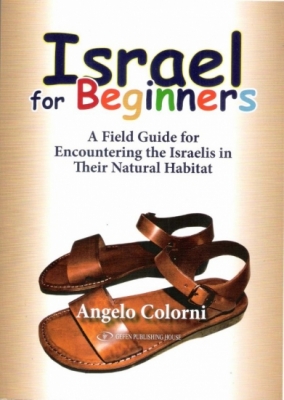Israel for Beginners
ISRAEL FOR BEGINNERS: A Field Guide for Encountering the Israelis in their Natural Habitat
by Angelo Colorni
Illustrations by Avi Katz
Gefen Publishing House. Soft Cover. 146 pages.
ISBN: 978-965-229-483-8
Reviewed by Carl Hoffman
I teach a course in English reading comprehension at Israel's Open University. Specifically, I help Hebrew-speaking Israeli students in the social sciences, psychology and education approach and understand professional journal articles written in academic-level English. One of the first things I ask my students to do before reading any article is to ponder the title and try to extract from it as much meaning as possible. I ask them to do this as thoroughly as my grandmother used to extract juice from oranges when I was a little kid.
The title of Angelo Colorni's new book tells us two basic things. We are able to conclude, without much difficulty, that this is intended to be a book of funny sketches about Israelis and not a grimly serious treatise on how to live in Israel. And we can infer that this is a book that will appeal far more to people who know Israel, and who have lived in Israel for a period of time, than it will to "beginners".
It takes a bit of experience in this sometimes charming, sometimes exasperating, but always fascinating country to be able to appreciate Colorni's droll sketches of everything from Israeli shopping habits to driving etiquette, from local food to fashion, and from the country's impregnable bureaucracy to its often incomprehensible language. So, to all of you new and prospective immigrants out there, I suggest that you ignore this book for the present and get as much clear, sober information as you can from your friends and relatives already here. To those of you who have been here for a while, however, I suggest grabbing a copy of this book and going off to read it someplace where your raucous laughter will not disturb your neighbors. And to native "sabra" Israelis, let me say that Ilook forward to a similarly amusing book written by one of you, that will hilariously describe the often bizarre manners, customs, mores and folkways of Israel's ever-exotic Anglo-Saxon immigrants.
Colorni's wit is razor sharp and his writing is superb. His chapter on driving begins with the sentence, "One of the first things that strikes a stranger in Israel is often a car." He begins a discussion of Israeli bureaucracy with, "Asking the Israelis what they think of the Israeli bureaucracy is tantamount to asking fire hydrants or lampposts what they think of dogs." And his introduction to a lengthy and informative chapter on names is a tour de force: "In Israel only natives can comfortably wade, and not get confused, through names and nicknames like Dudu, Dudi, Dedi, Didi, Bibi, Bebe, Beber, Momo, Momi, Ido, Odi, Udi, Uri, Ori, Orli, Orit, Irit, Iris, Nurit, Mirit, Miri, Mila, Mali, Nili, Lili, Gad, Gal, Galit, Gali, Gili, Gidi, Gadi, Tomer, Timor, Tamir, Amir, Yair, Meir, Noa, Noam, Noach, Simi, Shimi, Shiri, Shirli, Shula, Shuki, Shaki, Yaki, Miki, Muki, Buki, Beki…all names that to a non-native ear sound more like a suitcase falling down a flight of stairs." The author isn't just playing for belly laughs, however. Colorni quite helpfully provides us with a glossary of some of the more common Israeli names. If you do not speak Hebrew and have wondered what some of the names of people with whom you come into daily contact actually mean, this chapter will provide you with a ready reference.
It is also within the context of names that the author introduces us to "Etty," a lady who recurs as a generic character throughout the book. Who is Etty? Colorni explains, "Etty is an Israeli institution. Etty is the name of the girl you find behind the teller's window at the bank, post office, police station, telephone exchange or behind the desk of practically every government office. If you stood for an hour in a long line and your turn has finally arrived, Etty is the person who informs you that you have been standing in the wrong line or that you should have filled out a different form, and sends you back to the end of the line. Etty is the clerk who assures you that your file has not been lost, just temporarily misplaced, who always makes/takes personal calls to/from her sweetheart when you are in a hurry." As might be expected, we encounter Etty on numerous occasions throughout the course of this book.
Unlike Gaul, Israel for Beginners is divided into five parts: The Language, The People, The Lifestyle, The Land, and The Flip Side of the Coin. It is the first part, on Hebrew as a language, where the author's brilliant insights betray a keen understanding of linguistics in general and of Hebrew in particular. His crackling little essays range from foreign accents to the pitfalls of learning Hebrew. Even here, Colorni is funny in a "spot on" kind of way. Hebrew dictionaries, he says, "are of limited help, because you have to know how a word is spelled before you can look it up to check how it is spelled."
The author is at his witty best in the sections of the book on people and lifestyle, but least successful in his section, The Land. Here, he chooses to profile specific places in Israel and does so disappointingly. One wonders, for example, why an already short sketch on Tel Aviv focuses primarily on the old Central Bus Station which no longer exists. Colorni gets serious, however, in The Flip Side of the Coin, where his love for Israel becomes dramatically apparent, and which should be read by anyone who wonders occasionally why he made aliya, or why he is still here.








Comments